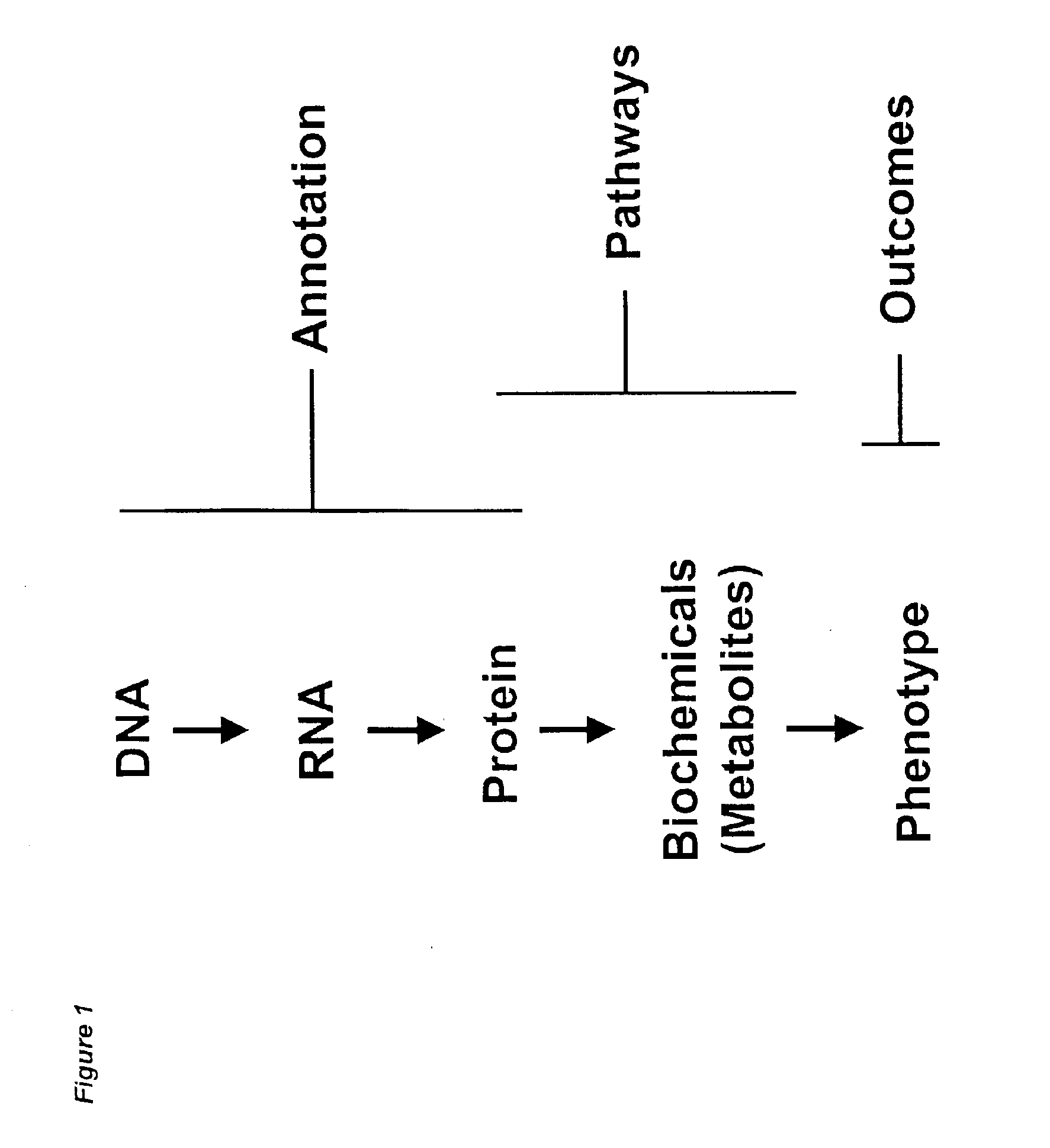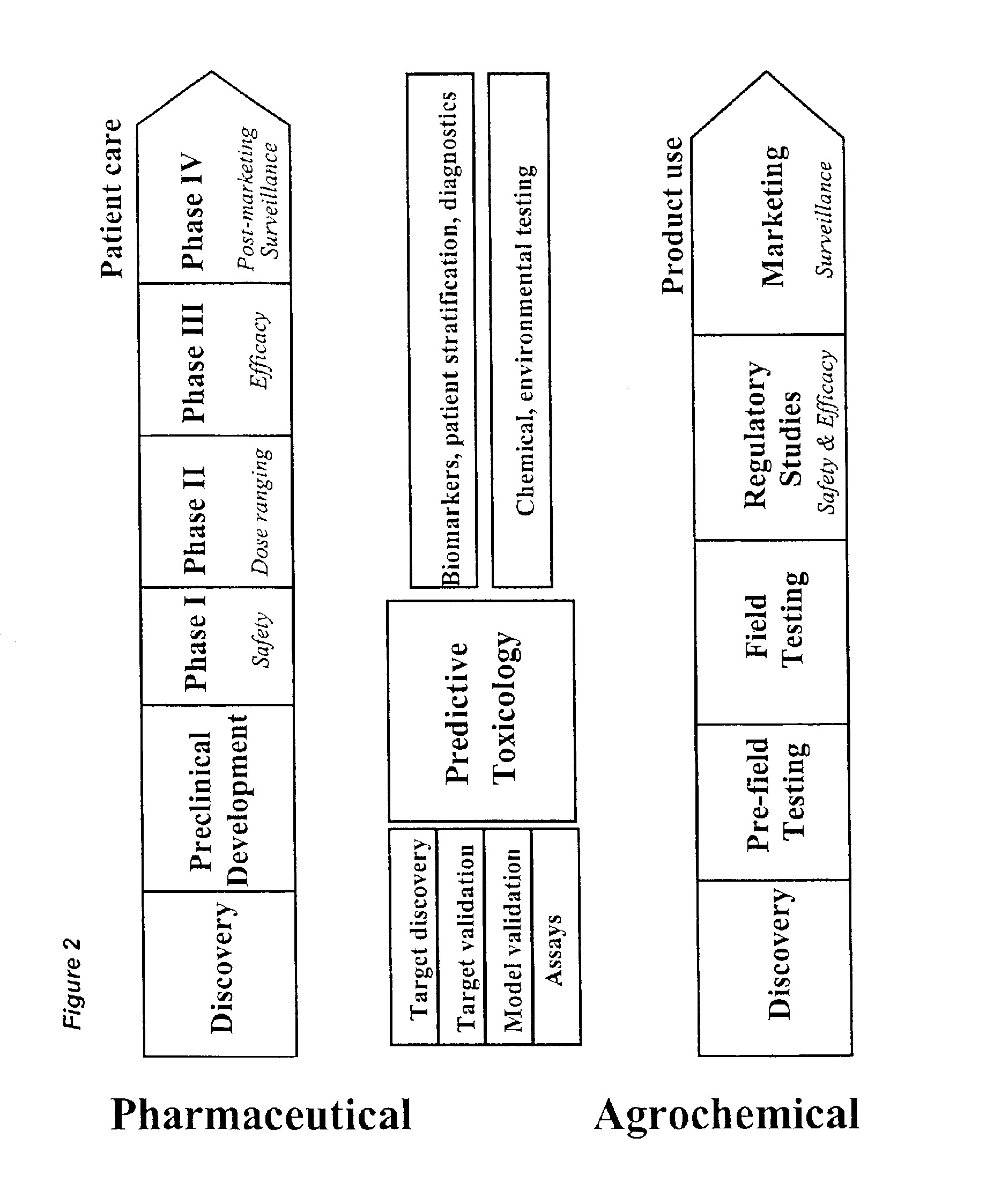Methods and systems for analyzing complex biological systems
a biological system and biological technology, applied in chemical methods analysis, analogue processes for specific applications, instruments, etc., can solve the problems of obfuscating the development of a pharmaceutical or agricultural product, linear relationship between gene and function being recognized as overly simplistic, and the genomics era has yet to provide an accelerated rou
- Summary
- Abstract
- Description
- Claims
- Application Information
AI Technical Summary
Benefits of technology
Problems solved by technology
Method used
Image
Examples
specific example 1
Preparation of a Database of Endogenous Metabolites for Arabidopsis Thaliana
To generate a database of metabolites, a list of potentially detectable plant compounds for each analysis methodology was created using the known function and metabolic pathways of the plant tissue to be studied. In addition, spectral peaks routinely observed in the plant samples were catalogued in the database. In some cases, data corresponding to the spectral peaks without a confirmed identity indicated additional compounds of interest for validation. The process for generating the database of endogenous metabolites was as follows: nominate compounds of interest, obtain the compounds (if possible), prepare and perform metabolite analysis of the compounds and the plant samples, process the spectral data, and add the spectral data and other compound / sample information to the database of endogenous metabolites (FIG. 3).
In order that the spectral data collected for the compounds in the database of endogenous ...
specific example 2
Creation of a Coherent Data Set for Grouping Herbicides by Site of Action
Described herein is an approach that integrates and standardizes three types of data: gene expression, metabolite (or biochemical) data, and phenotypic (or morphologic) data, to capture a larger share of cellular information than that which is otherwise available from collective results of the three data types. The resulting coherent data was applied to the grouping of herbicides by SOA in Arabidopsis. Phenotypic, gene expression, and metabolite analysis was performed on Arabidopsis tissues treated with 18 herbicides having nine different sites of action (Table 3). Data types were standardized to allow for simultaneous testing of all the data types or any combination of data types. Data were tested for the ability to accurately indicate the grouping of the herbicides by common SOA. The results indicate that no individual or pair-wise combination of the data types yielded the predictive power achieved by combini...
specific example 3
Herbicide Mode-of-Action Analysis
Herbicides have contributed extensively to increases in crop yield by eliminating or reducing the impact of competitive plant species. Although there are presently numerous registered compounds marketed in thousands of commercial products, there remains a need for new active herbicidal ingredients. Factors that contribute to the need for new active ingredients include the development of herbicide-resistant plant species and stricter regulations for reducing toxicological and environmental effects.
Understanding the mode-of-action and more specifically identifying the site- or pathway-of-action of existing and new herbicidal candidates is extremely valuable. Identification of the target(s) of a herbicidal compound prompts many options that may affect the decision for continued development of that compound. For example, if the target is not novel, continued work on the candidate compound may be stopped. Conversely, additional screening against the targe...
PUM
 Login to View More
Login to View More Abstract
Description
Claims
Application Information
 Login to View More
Login to View More - R&D Engineer
- R&D Manager
- IP Professional
- Industry Leading Data Capabilities
- Powerful AI technology
- Patent DNA Extraction
Browse by: Latest US Patents, China's latest patents, Technical Efficacy Thesaurus, Application Domain, Technology Topic, Popular Technical Reports.
© 2024 PatSnap. All rights reserved.Legal|Privacy policy|Modern Slavery Act Transparency Statement|Sitemap|About US| Contact US: help@patsnap.com










